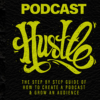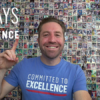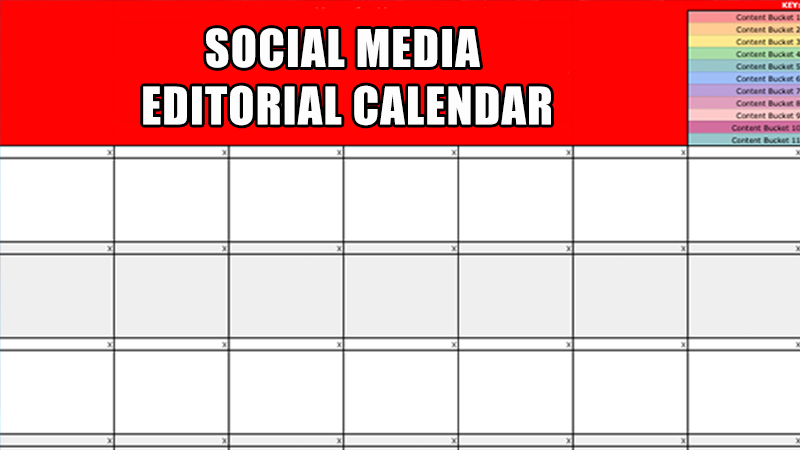
When it comes to social media, the best way to earn traffic is through consistent publishing.
Creating one or two great posts might get some attention, but I’ve noticed it takes most brands 200-300 high-quality posts before they see real traction. Publishing this many posts helps you:
- Become faster, more efficient at creating content
- Grow momentum using your social media strategy
- Get a better understanding of what your audience wants
- Create more opportunities for someone to find your brand
- Come up with more ideas that lead to more insightful content
- Earn a reputation for showing up with value
If you want improve your consistency and content quality, using an editorial calendar can be the perfect solution.
In this post, I’ll teach you exactly how to set up your editorial calendar and cover a few tools you can use to create and share high-quality content.
What is an Editorial Calendar?
An editorial calendar is an essential tool for planning what content to share when, managing your social media campaigns, and keeping track of all your deadlines.
It’s the same tool the pros at the biggest news sites and magazines use to plan their content ahead of time. Not only can it help you organize your ideas, but it can also structures your entire content creation process, from idea to promotion.
The best part about using a calendar is that you’ll always have quality content to consistently share with your audience. If you can get this out of the way weeks or months in advance, it’ll free up your time to work on other parts or your business or come up with ideas to leverage real-time opportunities to trend on social media.
When I led social media for a Fortune 10 company, I used to look up hashtags that would trend every single year (think holidays or events). Using a calendar gave us time to create high-quality, clever posts around the Oscar’s, TV show season premieres, and National Taco Day MONTHS before any of it happened. By the time other brands were noticing it was a trending topic, we were already racking up tons of engagement and shares.
Here are a few other benefits:
- Post on a regular basis
- Bank of ideas when you’re lacking inspiration
- Visually see upcoming content
- Plan seasonal content
- Less stress, more traffic
- Easy to track what topics worked best
- Track content that’s still in progress
- Feeds your social networks regularly
Now you can see why using a social media calendar is such a powerful way to grow your following.
What Does a Social Media Calendar Look Like?
Social media calendars come in different shapes and sizes.
They can be as simple or detailed as you like, as long as it’s effective in helping you brainstorm and plan your ideas. There are three things you need before you can create an effective calendar:
- Strategy for how you will use social media
- Clear goals for your social media channels
- Solid understanding of customers you’re trying to reach
Here are a few different types of calendars you can use.
Old School: Printed Calendar
It may seem outdated, but it’s effective. This is what I would do whenever I had multiple projects going on and wanted to keep track of everything without constantly switching tabs on my browser. But instead of printing a calendar, I used sharpies and post-it notes on my window.
Here’s how it worked:
- I created four buckets: priority, upcoming, in progress, published
- I used different color post-its for different themes/topics
- When I started or finished, I’d move the post-it to the appropriate column
This is especially helpful for visually mapping out content with a group of people in the same room and even more helpful when you need to constantly/instantly be aware of what’s happening during a campaign.
Standard: Custom Spreadsheet
This is the format I use the most. It’s cost effective, can be shared easily with collaborators, and can be edited to look and function to your heart’s desire. There are few common ways brand use spreadsheet calendars:
Monthly Calendar: shows everything that’s happening on your social channels at a glance.
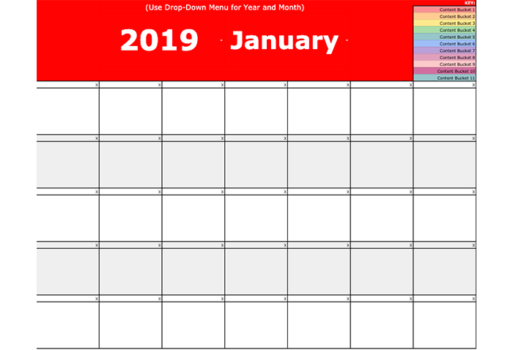
Posting Calendar: shows each post that you will publish across your social channels. Using different columns, you can track themes, content types, accompanying assets, and deadlines.

Campaign Calendar: visually shows how your campaign content will be published and promoted throughout the month.

For your benefit, we’ve combined these three calendars into one, easy to use template you can use to build your own editorial calendar. More on that in the next section.
Advanced: Social Media Management Tool
Like I said, these are effective for scheduling, analyzing, and publishing content, all in one place. These tools also allow for automation by letting you schedule content ahead of time, manage and optimize campaigns, and publish instant reports.
While social media management tools like Sprinklr, Buffer or Sprout Social is arguably more efficient, you may be limited by the number of seats or the functionality of the tools. Worst of all, if the tool crashes or is down, you’ve lost access to your calendar system. This is why you should use a spreadsheet as a backup mechanism even if you use a tool to manage your social media channels.
How to Create Your Social Media Calendar
Begin by downloading our Free Social Media Editorial Calendar Template. This easy-to-use spreadsheet will make planning and tracking content simple, no matter how many networks you’re active on.
If you’re new to the idea of planning content, here are 5 steps to help you build a calendar that achieves max results:
1: Choose The Right Content Buckets
Content buckets help you split your brand message into broad topics that your audience is interested in. If your brand’s mission statement is a table, your buckets are your legs. Picking a few lanes help you go deeper into your niche while making planning easier for you.
Let’s say you have a blog on personal fitness, your buckets could be nutrition, weight loss, techniques, exercises, and stretching. You could also get creative and have content buckets like #FitnessFriday, Workout of the Day, or What I’m Eating.
You can make this as simple or strategic as you like and evolve as you go. Here are three tips for coming up with content buckets:
- In one sentence, write out what your core topic or message
- Choose a topic that’s broad enough to support several sub-topics
- Tie back all of your content to your social media goals and customer avatars
2: Decide Your Ideal Content Mix
People like to engage with content in different ways across each social channel. A good content mix means users engage more with your brand and gives you multiple ways to tell your story. That’s less work for you when it comes to content creation!
- Video (Short/Long)
- Live Streams
- Infographics
- Audio/Podcast
- SlideShare
- GIFs
- Images/Memes
- Quizzes/Polls
- Articles/Blogs
3: Pick A Manageable Content Frequency
Remember, the goal here is to earn traffic is through consistent publishing, that means whatever frequency you decide on has to be sustainable. Some people will tell you to post 5x a day, but that’s going to be to no benefit for you if you only do it once and burn out.
Always keep your audience in mind. Ask yourself a series of questions:
- How often do they want to hear from me?
- How often can I deliver high-quality posts?
- What frequency can I sustain indefinitely?
Your audience may want a lot of posts from you, but their interest will take a nosedive if you sacrifice your quality to make that happen. It’s okay to keep them wanting more, but it’s unacceptable to sacrifice quality and lose their trust.
4: Brainstorm a List of Content Ideas
I learned this one from the Easy Social Strategy instructor himself, Rob Cressy.
There are some days that you’re going to have trouble coming up with great content ideas. Other days, you’re going to be a CONTENT MACHINE. Don’t be one of those people that complain about writer’s block, instead use these hot days to your advantage by creating a running list of great content ideas. When you’re running low on inspiration, visit the list and make it happen.
If you’re committed to this 200-300 post traction range, then start writing down ideas. Schedule 1 hour a week to brainstorm 50-100 ideas. Sure, not all of these are going to be winners, but at the very minimum you’re going to have a pool of 200-400 ideas you can revisit in just ONE month.
5: Fill in Your Calendar
Fill in your calendar using your content ideas, themes, and mix. As you look at it, you’ll begin to visually see holes in your content. Maybe a few topics are related in you see a natural series shaping up. You might notice that some things work and some things don’t. Even better, you notice there are holidays you can tie into or sensitive dates you need to avoid. All of these timely events will help you represent your brand in a better light.
Consider this: imagine every week you have a funny post on Fridays, but this Friday lands on September 11 or a tragedy happens the Thursday right before. This calendar will help you pay attention to those little details that will go a long way in humanizing your brand and resonating with your audience.
Over to Your Social Media Calendar
Let’s recap.
The best way to grow your social media following is through consistently publishing high quality content. Editorial calendars are tools that make planning those posts quicker and easier. The main idea is to plan far ahead enough to give yourself time to create content that resonates with your audience. Now you have a template to help you do that and the 5 steps needed to maximize your results.
I’d love to hear about the content buckets you picked and how you’re using an editorial calendar to plan posts and campaigns. And as always, if you want to learn the step-by-step process we use to create social strategies for our industry-leading clients, sign up for our upcoming Easy Social Strategy course.


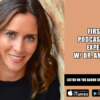



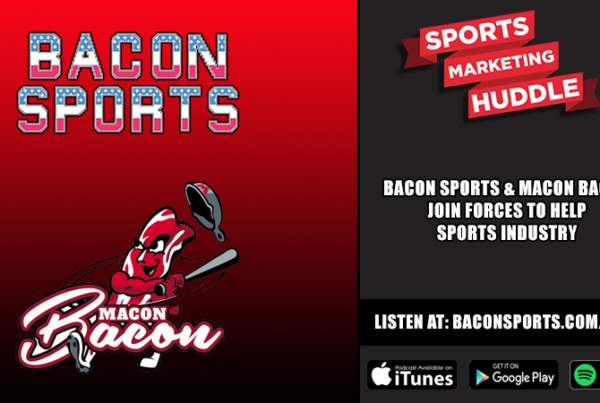

 Bacon Sports is a sports content & social media marketing agency that turns your audience into raving fans by creating fun and engaging videos, podcasts, and social media content.
Bacon Sports is a sports content & social media marketing agency that turns your audience into raving fans by creating fun and engaging videos, podcasts, and social media content.